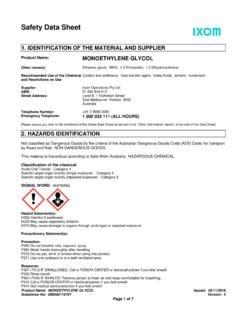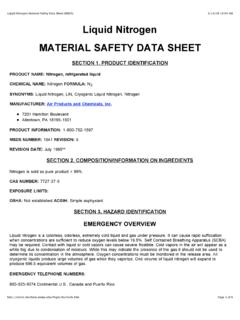Transcription of POTASSIUM HYDROXIDE - LIQUID - Orica
1 Safety Data Sheet 1. IDENTIFICATION OF THE MATERIAL AND SUPPLIER. Product Name: POTASSIUM HYDROXIDE - LIQUID . Other name(s): POTASSIUM HYDROXIDE liquor; Caustic potash LIQUID ; POTASSIUM hydrate; LIQUID caustic potash 49%; Caustic potash 50% LIQUID ; POTASSIUM HYDROXIDE LIQUID ; KOH LIQUID . Recommended Use of the Chemical Glass production, cleaner, process cleaner, petroleum industry. and Restrictions on Use Supplier: Ixom Operations Pty Ltd ABN: 51 600 546 512. Street Address: Level 8, 1 Nicholson Street East Melbourne Victoria 3002. Australia Telephone Number: +61 3 9906 3000. Emergency Telephone: 1 800 033 111 (ALL HOURS). Please ensure you refer to the limitations of this Safety Data Sheet as set out in the "Other Information" section at the end of this Data Sheet. 2. HAZARDS IDENTIFICATION. Classified as Dangerous Goods by the criteria of the Australian Dangerous Goods Code (ADG Code) for Transport by Road and Rail; DANGEROUS GOODS.
2 This material is hazardous according to Safe Work Australia; HAZARDOUS CHEMICAL. Classification of the chemical: Corrosive to Metals - Category 1. Acute Oral Toxicity - Category 4. Skin Corrosion - Sub-category 1A. Eye Damage - Category 1. SIGNAL WORD: DANGER. Hazard Statement(s): H290 May be corrosive to metals. H302 Harmful if swallowed. H314 Causes severe skin burns and eye damage. Precautionary Statement(s): Prevention: P234 Keep only in original container. P260 Do not breathe dust / fume / gas / mist / vapours / spray. P264 Wash hands thoroughly after handling. P270 Do not eat, drink or smoke when using this product. P280 Wear protective gloves / protective clothing / eye protection / face protection. Product Name: POTASSIUM HYDROXIDE - LIQUID Issued: 13/07/2015. Substance No: 000031007101 Version: 5. Page 1 of 7. Safety Data Sheet Response: P301+P330+P331 IF SWALLOWED: Rinse mouth. Do NOT induce vomiting.
3 P301+P312 IF SWALLOWED: Call a POISON CENTER or doctor/physician if you feel unwell. P303+P361+P353 IF ON SKIN (or hair): Take off immediately all contaminated clothing. Rinse skin with water/shower. P321 Specific treatment (see First Aid Measures on Safety Data Sheet). P363 Wash contaminated clothing before re-use. P304+P340 IF INHALED: Remove person to fresh air and keep comfortable for breathing. P310 Immediately call a POISON CENTER or doctor/physician. P305+P351+P338 IF IN EYES: Rinse cautiously with water for several minutes. Remove contact lenses, if present and easy to do. Continue rinsing. P390 Absorb spillage to prevent material damage. Storage: P405 Store locked up. P406 Store in corrosive resistant container with a resistant inner liner. Disposal: P501 Dispose of contents and container in accordance with local, regional, national, international regulations. Poisons Schedule (SUSMP): S6 Poison.
4 3. COMPOSITION AND INFORMATION ON INGREDIENTS. Components CAS Number Proportion Hazard Codes Water 7732-18-5 50-52% - POTASSIUM HYDROXIDE 1310-58-3 48-50% H290 H302 H314 H318. 4. FIRST AID MEASURES. For advice, contact a Poisons Information Centre ( phone Australia 131 126; New Zealand 0800 764 766) or a doctor. Inhalation: Remove victim from area of exposure - avoid becoming a casualty. Remove contaminated clothing and loosen remaining clothing. Allow patient to assume most comfortable position and keep warm. Keep at rest until fully recovered. For all but the most minor symptoms arrange for patient to be seen by a doctor as soon as possible, either on site or at the nearest hospital. If respiration or pulse has stopped, have a trained person administer basic life support (Cardio-Pulmonary Resuscitation and/or Automatic External Defibrillator) and call Emergency Services immediately. Skin Contact: If spilt on large areas of skin or hair, immediately drench with running water and remove clothing.
5 Continue to wash skin and hair with plenty of water (and soap if material is insoluble) until advised to stop by the Poisons Information Centre or a doctor. Eye Contact: If in eyes, hold eyelids apart and flush the eye continuously with running water. Continue flushing until advised to stop by a Poisons Information Centre or a doctor, or for at least 15 minutes. Ingestion: Immediately rinse mouth with water. If swallowed, do NOT induce vomiting. Give a glass of water. Never give anything by the mouth to an unconscious patient. Seek immediate medical assistance. Product Name: POTASSIUM HYDROXIDE - LIQUID Issued: 13/07/2015. Substance No: 000031007101 Version: 5. Page 2 of 7. Safety Data Sheet Indication of immediate medical attention and special treatment needed: Treat symptomatically. Can cause corneal burns. Possible mucosal damage may contraindicate the use of gastric lavage. 5. FIRE FIGHTING MEASURES.
6 Suitable Extinguishing Media: Not combustible, however, if material is involved in a fire use: Fine water spray, normal foam, dry agent (carbon dioxide, dry chemical powder). Hazchem or Emergency Action Code: 2R. Specific hazards arising from the chemical: Non-combustible material. Corrosive substance. May evolve flammable hydrogen gas on contact with metals. Special protective equipment and precautions for fire-fighters: Fire fighters to wear self-contained breathing apparatus and suitable protective clothing if risk of exposure to products of decomposition. If safe to do so, remove containers from path of fire. Keep containers cool with water spray. 6. ACCIDENTAL RELEASE MEASURES. Emergency procedures/Environmental precautions: Clear area of all unprotected personnel. If contamination of sewers or waterways has occurred advise local emergency services. Personal precautions/Protective equipment/Methods and materials for containment and cleaning up: Slippery when spilt.
7 Avoid accidents, clean up immediately. Wear protective equipment to prevent skin and eye contact and breathing in vapours. Work up wind or increase ventilation. Contain - prevent run off into drains and waterways. Use absorbent (soil, sand or other inert material). Neutralise residues with dilute acid. Collect and seal in properly labelled containers or drums for disposal. Wash area down with excess water. For large amounts, pump off product. 7. HANDLING AND STORAGE. This material is a Scheduled Poison S6 and must be stored, maintained and used in accordance with the relevant regulations. Precautions for safe handling: Avoid skin and eye contact and breathing in vapour, mists and aerosols. Keep out of reach of children. Conditions for safe storage, including any incompatibilities: Store in a cool, dry, well ventilated place. Store away from incompatible materials described in Section 10. Do not store in aluminium or galvanised containers nor use die-cast zinc or aluminium bungs; steel bungs should be used.
8 Store away from foodstuffs. Keep containers closed when not in use - check regularly for leaks. 8. EXPOSURE CONTROLS/PERSONAL PROTECTION. Control Parameters: No value assigned for this specific material by Safe Work Australia. However, Workplace Exposure Standard(s) for constituent(s): POTASSIUM HYDROXIDE : Peak Limitation = 2 mg/m3. Product Name: POTASSIUM HYDROXIDE - LIQUID Issued: 13/07/2015. Substance No: 000031007101 Version: 5. Page 3 of 7. Safety Data Sheet As published by Safe Work Australia Workplace Exposure Standards for Airborne Contaminants. Peak Limitation - a maximum or peak airborne concentration of a particular substance determined over the shortest analytically practicable period of time which does not exceed 15 minutes. These Workplace Exposure Standards are guides to be used in the control of occupational health hazards. All atmospheric contamination should be kept to as low a level as is workable.
9 These workplace exposure standards should not be used as fine dividing lines between safe and dangerous concentrations of chemicals. They are not a measure of relative toxicity. Appropriate engineering controls: Ensure ventilation is adequate and that air concentrations of components are controlled below quoted Workplace Exposure Standards. Keep containers closed when not in use. If in the handling and application of this material, safe exposure levels could be exceeded, the use of engineering controls such as local exhaust ventilation must be considered and the results documented. If achieving safe exposure levels does not require engineering controls, then a detailed and documented risk assessment using the relevant Personal Protective Equipment (PPE) (refer to PPE section below) as a basis must be carried out to determine the minimum PPE requirements. Individual protection measures, such as Personal Protective Equipment (PPE): The selection of PPE is dependent on a detailed risk assessment.
10 The risk assessment should consider the work situation, the physical form of the chemical, the handling methods, and environmental factors. OVERALLS, CHEMICAL GOGGLES, FACE SHIELD, GLOVES (Long), APRON, RUBBER BOOTS. Wear overalls, chemical goggles, face shield, elbow-length impervious gloves, splash apron or equivalent chemical impervious outer garment, and rubber boots. Always wash hands before smoking, eating, drinking or using the toilet. Wash contaminated clothing and other protective equipment before storage or re-use. If determined by a risk assessment an inhalation risk exists, wear a suitable mist respirator meeting the requirements of AS/NZS 1715 and AS/NZS 1716. 9. PHYSICAL AND CHEMICAL PROPERTIES. Physical state: Clear LIQUID Colour: Colourless Odour: Odourless Solubility: Miscible with water. Specific Gravity: @15 C. Relative Vapour Density (air=1): Not available Vapour Pressure (20 C): Not available Flash Point ( C): Not applicable Flammability Limits (%): Not applicable Autoignition Temperature ( C): Not applicable Boiling Point/Range ( C): 133-143.











